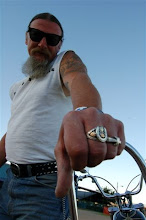I have a thing about fork stops. With most guys, deciding on the front end for their bikes is the easy part. How to keep their forks/handlebars from crashing into the front of their gas tanks seems to be an afterthought solution- especially with springer forks and girders.
Bolt-on, pad-type stops that locate to the bottom tree are OK, but the two that I dislike the most are the button head allen bolts that guys drill and tap their backbone for, so they contact the springer's back leg pads on at full lock. For one thing, that's a long way for the front forks to pivot before they contact the stops, limiting your gas tank placement on the backbone, so the forks or bars don't hit it. Plus, eventually the button heads mash to the point where the forks/handlebars actually do hit the tank. By then, the key socket in the allen is mashed closed as well, and removal for replacement usually means welding a nut to the buttonhead to take them out. Not fun. Plus, that's a couple big holes to drill and tap in the backbone at a stressed area. 99% of the guys don't weld in a bung to tap for the buttonheads.....can you say "cracks in the backbone..."?

The one's I really hate are the chains that are welded to the frame, and attached to the bottom tree. Those are UGLY, and like pipe wrap, seem to say to everybody "I couldn't figure out what else to do, so I did this....".
Hidden fork stops are relatively simple to install, and are.....hidden. With a little pre-planning, they'll work on 95% of the front ends, either springers, or glides. On most aftermarket springers, you simply unbolt (or press out) the steering stem, and use a short length of 1" dia. bar to locate the fork stop plate in position on the tree, and use it as a pattern to drill the holes for the mounting screws or pins.
For the springers (including the OEM-ones) with a welded in neck stem, it's not much more difficult to install them, just a little trickier. Here's how Elliot's hidden fork stop install turned out on his old Denvers springer. Eric over at Hot Bike magazine has asked me for a series of tech articles, and I have one almost ready to go, and I'm thinking one on installing hidden fork stops on springers (or glides for that matter) with non-removable neck stems would be another good one to do for him.

Another thing I noticed when I took Elliot's old Denvers springer apart. The upper springs have "locators" top and bottom that keep the springs in place, but the bottom springs only have a locator on the top - the bottom of the lower springs can rack back and forth when the front end is moving. You can see how the springs have danced around all these years. I don't know if this is the way they were all done, or if they just didn't make it on this one. We're going to remedy this as we go along. Hopefully, I can get this springer shortened soon, but I have to wait until the rear tire shows up, so I can block the frame to the right ride height to do it. I'm looking forward to doing the work, and the 21" front wheel that Elliot found for his project is one you've probably only seen pictures of in old ads, and it's NOS tits perfect, never run on anything.



























1 comment:
I love the idea of structural integrity being maintained, it's one thing to do your own choppin but entirely another to have it safe, solid and reliable. Good stuff mate.
Post a Comment